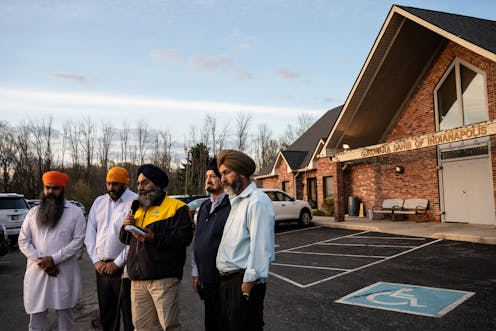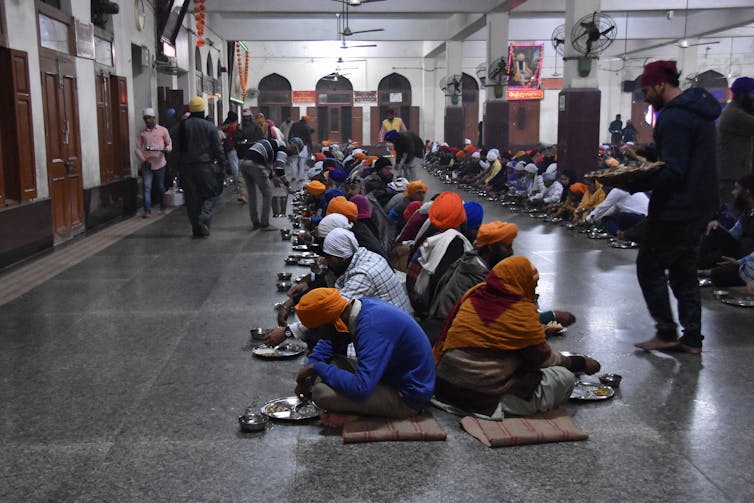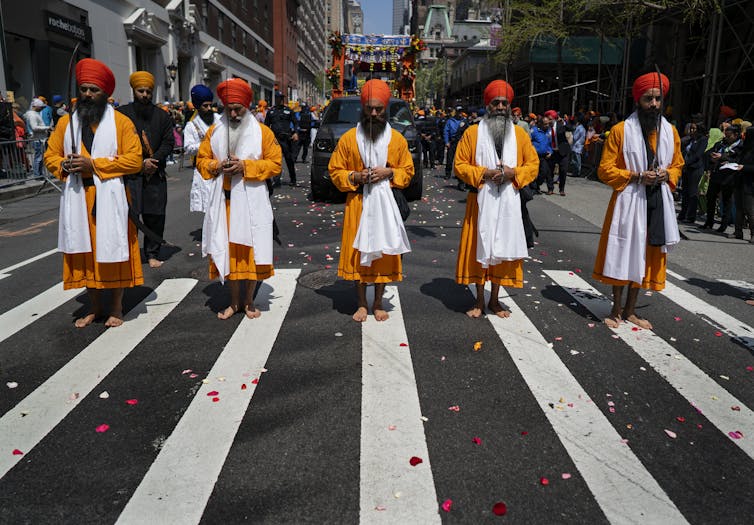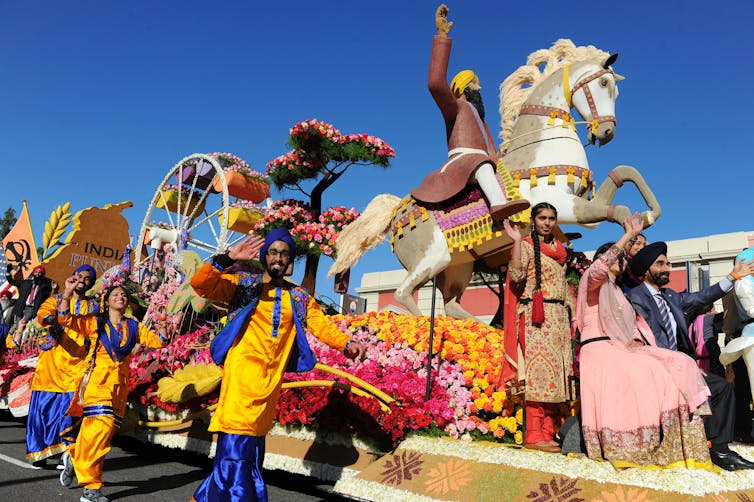Sikhs in America: A religious community long misunderstood is mourning deaths in Indianapolis mass s
A scholar explains the religious beliefs of Sikhs as well as the prejudices and barriers that many Sikhs in America face.

On April 16, 2021, a gunman opened fire at a FedEx facility in Indianapolis killing eight people and injuring several others before taking his own life. Four members of the Sikh community were among those gunned down.
The site was reported as having a significant number of Sikh employees, and the massacre has left the community shaken and in grief.
“I have sat with families from our community and so many others at the Holiday Inn Express as they wait to hear the fates of their loved ones,” said Maninder Singh Walia, a member of the Indianapolis Sikh community. “These kinds of violent attacks are a threat to all of us. Our community has a long road of healing – physically, mentally, and spiritually – to recover from this tragedy.”
The shooter’s motive is not yet known. In a statement following the incident, the Sikh Coalition, an advocacy group, called on authorities to conduct a full investigation “including the possibility of bias as a factor.”
Sikhs have in the past been targeted in racist attacks. As a scholar of the tradition and a practicing Sikh myself, I have studied the prejudices and barriers that many Sikhs in America face. I have also experienced racial slurs from a young age.
The bottom line is there is little understanding in the U.S. of who exactly the Sikhs are and what they believe. So here’s a primer.
Founder of Sikhism
To start at the beginning, the founder of the Sikh tradition, Guru Nanak, was born in 1469 in the Punjab region of South Asia, which is currently split between Pakistan and the northwestern area of India. A majority of the global Sikh population still resides in Punjab on the Indian side of the border.
From a young age, Guru Nanak was disillusioned by the social inequities and religious hypocrisies he observed around him. He believed that a single divine force created the entire world and resided within it. In his belief, God was not separate from the world and watching from a distance, but fully present in every aspect of creation.
He therefore asserted that all people are equally divine and deserve to be treated as such.
To promote this vision of divine oneness and social equality, Guru Nanak created institutions and religious practices. He established community centers and places of worship, wrote his own scriptural compositions and institutionalized a system of leadership (gurus) that would carry forward his vision.
The Sikh view thus rejects all social distinctions that produce inequities, including gender, race, religion and caste, the predominant structure for social hierarchy in South Asia.

Serving the world is a natural expression of Sikh prayer and worship. Sikhs call this prayerful service “seva,” and it is a core part of their practice.
The Sikh identity
In the Sikh tradition, a truly religious person is one who cultivates the spiritual self while also serving the communities around them – or a saint-soldier. The saint-soldier ideal applies to women and men alike.
In this spirit, Sikh women and men maintain five articles of faith, popularly known as the five Ks. These are: kes (long, uncut hair), kara (steel bracelet), kanga (wooden comb), kirpan (small sword) and kachera (soldier-shorts).
Although little historical evidence exists to explain why these particular articles were chosen, the five Ks continue to provide the community with a collective identity, binding together individuals on the basis of a shared belief and practice. As I understand, Sikhs cherish these articles of faith as gifts from their gurus.
Turbans are an important part of the Sikh identity. Both women and men may wear turbans. Like the articles of faith, Sikhs regard their turbans as gifts given by their beloved gurus, and its meaning is deeply personal. In South Asian culture, wearing a turban typically indicated one’s social status – kings and rulers once wore turbans. The Sikh gurus adopted the turban, in part, to remind Sikhs that all humans are sovereign, royal and ultimately equal.
[3 media outlets, 1 religion newsletter. Get stories from The Conversation, AP and RNS.]\
Sikhs in America
Today, there are approximately 30 million Sikhs worldwide, making Sikhism the world’s fifth-largest major religion.

After British colonizers in India seized power of Punjab in 1849, where a majority of the Sikh community was based, Sikhs began migrating to various regions controlled by the British Empire, including Southeast Asia, East Africa and the United Kingdom itself. Based on what was available to them, Sikhs played various roles in these communities, including military service, agricultural work and railway construction.
The first Sikh community entered the United States via the West Coast during the 1890s. They began experiencing discrimination immediately upon their arrival. For instance, the first race riot targeting Sikhs took place in Bellingham, Washington, in 1907. Angry mobs of white men rounded up Sikh laborers, beat them up and forced them to leave town.
The discrimination continued over the years. For instance, after my father moved from Punjab to the United States around the time of the Iran hostage crisis in 1979 and racial slurs like “Ayatollah” and “raghead” were hurled at him. It was a time when 52 American diplomats and citizens were taken captive in Iran and tension between the two countries was high. These slurs reflected the racist backlash against those who fitted the stereotypes of Iranians. Our family faced a similar racist backlash when the U.S. engaged in the Gulf War during the early 1990s.
The racist attacks spiked again after 9/11, particularly because Americans did not know about the Sikh religion and conflated the unique Sikh appearance with popular stereotypes of what terrorists look like.
The rates of violence against Sikhs surged after the election of President Donald Trump. The Sikh Coalition estimated in 2018 that Americans Sikhs were being targeted in hate crimes about once a week.

Scholars and government officials estimate the Sikh American population to number around 500,000.
As a practicing Sikh, I can affirm that the Sikh commitment to the tenets of their faith, including love, service and justice, keeps them resilient in the face of violence. For these reasons, many Sikh Americans, including those affected by the mass shooting in Indiana, I believe, will continue to maintain their unique Sikh identity, proudly and apologetically.
This is an updated version of an article first published on Aug. 9, 2018.

Simran Jeet Singh does not work for, consult, own shares in or receive funding from any company or organization that would benefit from this article, and has disclosed no relevant affiliations beyond their academic appointment.
Read These Next
What’s at stake in Trump’s executive order aiming to curb state-level AI regulation
In the absence of comprehensive federal AI regulation, states have stepped in. The Trump administration,…
The Bible says little about Jesus’ childhood – but that didn’t stop medieval Christians from enjoyin
Legends about Jesus’ early years that circulated in medieval Europe often drew on apocryphal texts.
Sleep problems and depression can be a vicious cycle, especially during pregnancy − here’s why it’s
Inadequate sleep can have negative downstream effects on everyday cognitive functioning and mental health,…





